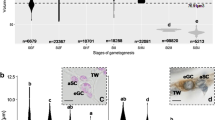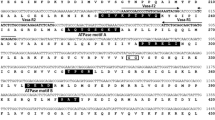Abstract
In bivalve, the distribution of primordial germ cells can be traced from early embryogenesis to the veliger larva by the expression of the vasa ortholog. However, the distribution of germ cells from metamorphosis to maturation in bivalves has not been examined extensively. In this study, we used in situ hybridization to observe expression of the Mytilus galloprovincialis vasa-like gene (Myvlg). The distribution of germ cells was clarified in immature mussels. We observed germ cells in adult mussels during the non-reproductive and reproductive seasons. Myvlg was specifically expressed in germ cells. Gametogenesis occurs in acini surrounded by connective tissue. Myvlg expression was detected in spermatogonia, spermatocytes, oogonia, and oocytes. In the non-reproductive season, gametes were not observed in the acini, but Myvlg was expressed in germinal stem cells along the acini. The expression intensity in the non-reproductive season, however, was much weaker than that in the reproductive season. Myvlg-positive cells proliferated during the non-reproductive season. In immature mussels, a pair of germ cell clumps was distributed laterally in the connective tissue between the nephric tubules and posterior byssal retractor muscle. Germ cells were also observed along pericardium. When immature mussels grew, a pair of germ cell clumps migrated anteriorly in the connective tissue along the outer epithelium at the dorsal region of the mantle base between the mantle and gill. The number of germ cells increased significantly as the mussels grew. This is the first report to observe the proliferation and migration of germ cells in immature mussels.








Similar content being viewed by others
References
Cardinali M, Gioacchini G, Candiani S, Pestarino M, Yoshizaki G, Carnevali O (2004) Hormonal regulation of vasa-like messenger RNA expression in the ovary of the marine teleost Sparus aurata. Biol Reprod 70:737–743
Castrillon DH, Quade BJ, Wang TY, Quigley C, Crum CP (2000) The human VASA gene is specifically expressed in the germ cell lineage. Proc Natl Acad Sci USA 97:9585–9590
Dayhoff MO, Schwartz RM, Orcutt BC (1978) A model of evolutionary change in proteins. In: Atlas of protein sequence and structure. National Biomedical Research Foundation, Silver Spring, MD, pp 345–352
Eddy EM (1975) Germ plasm and the differentiation of the germ cell line. Int Rev Cytol 43:229–281
Fabioux C, Huvet A, Lelong C, Robert R, Pouvreau S, Daniel JY, Minguant C, Le Pennec M (2004) Oyster vasa-like gene as a marker of the germ line cell development in Crassostrea gigas. Biochem Biophys Res Commun 320:592–598
Fujiwara Y, Komiya T, Kawabata H, Sato M, Fujimoto H, Furusawa M, Noce T (1994) Isolation of a DEAD-family protein gene that encodes a murine homolog of Drosophila vasa and its specific expression in germ cell lineage. Proc Natl Acad Sci USA 91:12258–12262
Hay B, Jan LY, Jan YN (1988) A protein component of Drosophila polar granules is encoded by vasa and has extensive sequence similarity to ATP-dependent helicases. Cell 55:577–587
Heasman J, Quarmby J, Wylie CC (1984) The mitochondrial cloud of Xenopus oocytes: the source of germinal granule material. Dev Biol 105:458–469
Janer G, Lavado R, Thibaut R, Porte C (2005) Effects of 17β-estradiol exposure in the mussel Mytilus galloprovincialis: a possible regulation role for steroid acyltransferases. Aquat Toxicol 75:32–42
Kautsky N (1982) Quantitative studies on gonad cycle, fecundity, reproductive output and recruitment in a Baltic Mytilus edulis population. Mar Biol 68:143–160
Komiya T, Itoh K, Ikenishi K, Furusawa M (1994) Isolation and characterization of a novel gene of the DEAD Box protein family which is specifically expressed in germ cell of Xenopus laevis. Dev Biol 162:354–363
Lin H (1997) The tao of stem cells in the germline. Annu Rev Genet 31:455–491
Lowe DM, Moore MN, Bayne BL (1982) Aspects of gametogenesis in the marine mussel Mytilus edulis L. J Mar Biol Ass UK 62:133–145
Lubet P (1959) Recherches sur le cycle sexual et l’emission des gametes chez les Mytilides et les Pectinides. Revue Trav Inst (scient tech) Pech marit 23:387–548
Mochizuki K, Nishimiya-Fujisawa C, Fujisawa T (2001) Universal occurrence of the vasa-related genes among metazoans and their germline expression in Hydra. Dev Genes Evol 211:299–308
Nakamura S, Osada M, Kijima A (2007) Involvement of GnRH neuron in the spermatogonial proliferation of the scallop, Patinopecten yessoensiss. Mol Reprod Dev 74:108–115
Newell RIE, Hilbish TJ, Koehn RK, Newell CJ (1982) Temporal variation in the reproductive cycle of Mytilus edulis L. (Bivalvia Mytilidae) from localities on the east coast of the United States. Biol Bull 162:299–310
Olsen LC, Aasland R, Fjose A (1997) A vasa-like gene in zebrafish identifies putative primordial germ cells. Mech Dev 66:95–105
Pazos AJ, Mathieu M (1999) Effects of five natural gonadotropin-releasing hormones on cell suspensions of marine bivalve gonad: stimulation of gonial DNA synthesis. Gen Comp Endocrinol 113:112–120
Pipe RK (1987) Ultrastructural and cytochemical study on interactions between nutrient storage cells and gametogenesis in the mussel Mytilus edulis. Mar Biol 96:519–528
Rebscher N, Zelada-Gonzalez F, Banisch TU, Raible F, Arendt D (2007) Vasa unveils a common origin of germ cells and of somatic stem cells from the posterior growth zone in the polychaete Platynereis dumerilii. Dev Biol 306:599–611
Roussel D, Bennett KL (1993) glh-1, a germ-line putative RNA helicase from Caenorhabditis has four zinc fingers. Proc Natl Acad Sci USA 90:9300–9304
Saffman EE, Lasko P (1999) Germline development in vertebrates and invertebrates. Cell Mol Life Sci 55:1141–1163
Saitou N, Nei M (1987) The neighbor-joining method: a new method for reconstructing phylogenetic trees. Mol Biol Evol 4:406–425
Schmid SR, Linder P (1992) D-E-A-D protein family of putative RNA helicases. Mol Microbiol 6:283–292
Schultz J, Milpetz F, Bork P, Ponting CP (1998) SMART, a simple modular architecture research tool: identification of signaling domains. Proc Natl Acad Sci USA 95:5857–5864
Shibata N, Umesono Y, Orii H, Sakurai T, Watanabe K, Agata K (1999) Expression of vasa (vas)-related genes in germline cells and totipotent somatic stem cells of Planarians. Dev Biol 206:73–87
Swartz SZ, Chan XY, Lambert JD (2008) Localization of Vasa mRNA during early cleavage of the snail Ilyanassa. Dev Genes Evol 218:107–113
Tamura K, Dudley J, Nei M, Kumar S (2007) MEGA4: molecular evolutionary genetics analysis (MEGA) software version 4.0. Mol Biol Evol 24:1596–1599
Wilkinson DG, Nieto MA (1993) Detection of messenger RNA by in situ hybridization to tissue sections and whole-mounts. Methods Enzymol 225:361–373
Woods FH (1931) History of the germ cells in Sphaerium striatinum (Lam.). J Morphol 51:545–595
Woods FH (1932) Keimbahn determinants and continuity of the germ cells in Sphaerium striatinum (Lam.). J Morphol 53:345–365
Yoshizaki G, Sakatani S, Tominaga H, Takeuchi T (2000) Cloning and characterization of a vasa-like gene in rainbow trout and its expression in the germ cell lineage. Mol Reprod Dev 55:364–371
Acknowledgments
We thank Misako Miwa for advice on the methodology of in situ hybridization. This study was supported by the Japan Society for the Promotion of Science Research Fellowship for Young Scientists (No. 05488).
Author information
Authors and Affiliations
Corresponding author
Additional information
Communicated by D.A. Weisblat
Rights and permissions
About this article
Cite this article
Obata, M., Sano, N., Kimata, S. et al. The proliferation and migration of immature germ cells in the mussel, Mytilus galloprovincialis: observation of the expression pattern in the M. galloprovincialis vasa-like gene (Myvlg) by in situ hybridization. Dev Genes Evol 220, 139–149 (2010). https://doi.org/10.1007/s00427-010-0335-3
Received:
Accepted:
Published:
Issue Date:
DOI: https://doi.org/10.1007/s00427-010-0335-3




